When I woke up this morning I realized that July 31 is coming up on Wednesday, which means there’s only a month of summer left. I panicked and fled to the letterpress shop to compose myself.
These little “ACT QUICKLY SUMMER IS ALMOST OVER” broadsides (can you call them broadsides if they’re not broad?) are printed on Japanese paper I bought in Tokyo in March at Ito Ya. It’s a “sampler pack” of 10cm x 10cm pieces, 100 to a pack, for ¥504 (about $5.25 Canadian).
I think the next level up in my career as a printer will be learning to cut lead type for kerning: the “LY” in “QUICKLY” is quite unappealing as it is here, rectangles being rectangles; cutting a notch in the “L” and the “Y” so that they can hug more naturally would fix that.


From June 28 to July 27 in 2007 this site received 30,906 visitors. They spent an average of 1 minute and 6 seconds here, and visited 1.64 pages on average. Here’s where they came from:
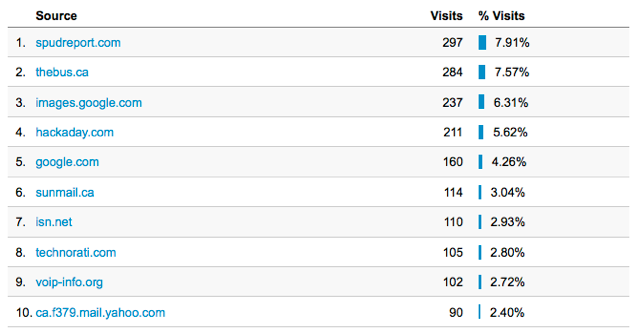
Six years later, from June 28 to July 28 in 2013 this site received 16,666 visitors. They spent an average of 1 minute and 26 seconds here, and visited 1.36 pages on average. Here’s where they came from:
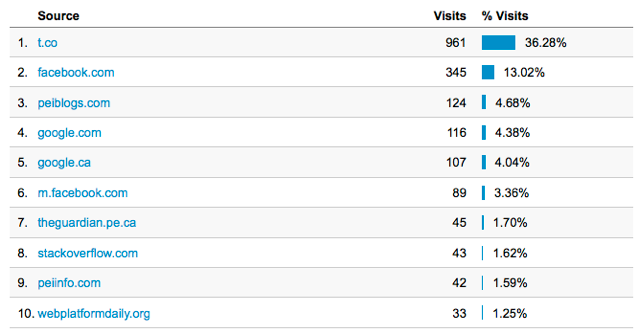
Other that Google, none of the top 10 sources that led visitors here in 2007 are still in the top 10. These days about 50% of all visitors come here through Twitter (t.co in the list above) or Facebook.
Here’s what that 6 years worth of visitors looks like, week by week; 2.2 million of you in all:

Oliver and I went for a walk last night after supper: I wanted to show off my new PirateBox so we took his laptop and browsed around for a while looking for something interesting.
We settled on Prince Edward Island: The England of Canada, a 1941 pamphlet from the IslandLives.ca collection that lives on the PirateBox. We opened up the PDF and found that there was a photo of Province House as it once was:
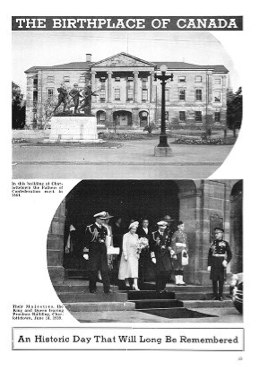
As we were just around the corner, we took a little walk and sat down and played a game of “spot the differences”:

A few pages later we came across a photo of Queen Street, taken from the corner of Queen and Richmond, and did the same “then and now” comparison (who knew that Woolworth’s was there before it moved up the street!):
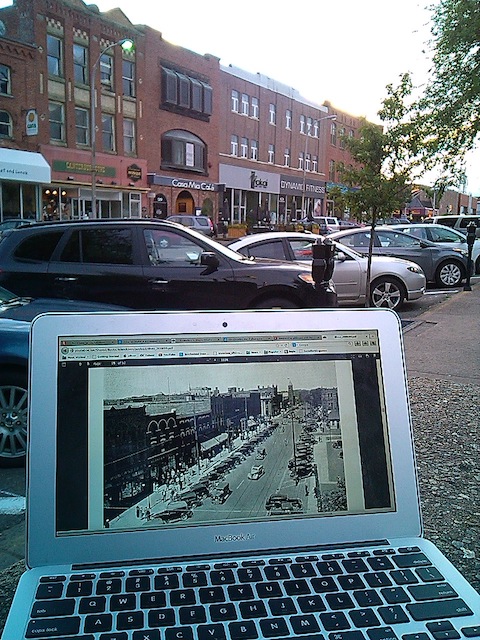
Prince Edward Island: The England of Canada is a great little read; you can grab it from IslandLives.ca or from the downtown PirateBox.
Twitter follower Chris MacDonald asks:

Here’s an easy way to find out:
- Go to the corner of Queen and Richmond Streets in downtown Charlottetown.
- Sit on the bench beside Sir John A. Macdonald.
- Open an wifi-capable portable device: laptop, mobile phone, tablet, etc.
- Connect to the wifi SSID PirateBox - Share Freely.
- Open your web browser and visit http://piratebox.lan/ (or, indeed, any web address).
- That is the PirateBox.
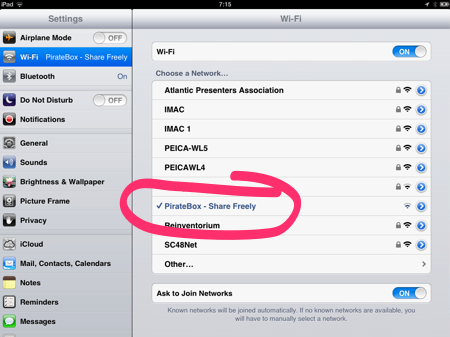
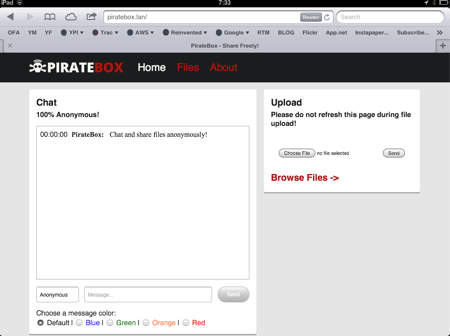
On this particular PirateBox you will find, under the Files link, many interesting things:
- An audiobook of Anne of Green Gables.
- HTML versions of many of L.M. Montgomery’s works, including Anne of Green Gables, Anne of Avonlea and Rainbow Valley.
- Several of Cory Doctorow’s books, both as HTML and ePub.
- Complete set of PDF versions of the Statutes of Prince Edward Island and the City of Charlottetown Bylaws.
- Several TED videos and some videos about PirateBox itself.
- Some music.
- Some podcasts.
- A complete set of PEI community histories from IslandLives.ca.
What’s more, you can share your own content using the Upload feature: just click Browse or Choose File under “Upload”, select a file you’d like to share, and your file will, once uploaded, become available to others in the “upload” folder.
All of this is happening disconnected from the Internet, running off a $35 box that you can buy on Amazon.com using software you can download for free.
1. Beware of Tricksters
One of those translations from German into English that adds a hint of intrigue.

2. Orange Crates in Sunshine
At the Motel One near the window on the fourth floor.

3. KANT Berlin Office
The Kreuzberg Academy for Nerdery and Tinkering.

4. Smokestack through Dusty Window
At the NYU Berlin office in the fourth floor.

5. Patching Pavement
In Berlin when they use hot tar to patch a hole in the street or sidewalk they spread sand on top to avoid the problem of sticky tar sticking to everything that walks or rolls over it.

My friend Luisa is helping to organize the Alibis for Interaction conference this fall in southern Sweden. It’s a conference that, once you hear its name, you either thing “yes!” or “huh?” and thus self-selects participants very nicely. From the description of the conference:
Designing for participation is giving the participants alibis for interaction. Designing for participation is designing experiences that take into account that humans have bodies, senses, fears, motivations; social hierarchies, prior knowledge, expectations, curiosity, and an innate urge to find out how the story ends. That we need to understand what we’re expected to do, to feel safe trying, to trust in the reward for braving something new.
Packed into that paragraph is as concise a description of the challenges I have interacting with the world as I’ve ever read.
Follow the conference blog (in English and deliciously well-written) to play along from home.
I’m about to check out of Motel One at Moritzplatz (a hotel that is labelled “Motel One Berlin-Mitte” but that is only in the most generous sense anywhere near Mitte); I’ve been here for the last 6 nights and it’s my second stay here (I was here last July as well). I’ve stayed in several neighbourhoods over the years that I’ve been coming to Berlin: Prenzlauer Berg, Mitte and Mitte again and Kreuzberg; while all are pleasant, here at Moritzplatz, on the fringes of Kreuzberg, is by far and away my favourite.
The Motel One is nothing to write home about, but it’s clean, cheap (about 60 EURO a night with breakfast included), has servicable wifi (4 Mbps down, 1Mbps up) and it’s quiet (especially if you request a room at the back). The staff are friendly and there’s a nice lounge on the first floor.
What sets Moritzplatz apart as a Berlin base, though, is everything that surrounds:
- The Moritzplatz U-Bahn stop is steps from the door of the hotel, and the U8 that stops there can take you quickly up to Mitte or down into Neukölln and, with a connection, you can be almost anywhere you need to go in central Berlin in 30 minutes or less.
- Betahaus, with its coworking desks, café, bandwidth and workshops, is just around the corner. And it’s open on Saturdays now.
- Modulor is right on Moritzplatz. It is, I think, the greatest store on earth: you can buy pens, paper, notebooks, architectural supplies, magnets, books, clay, rope, table saws, masking tape, suction cups… everything. And it’s all expertly organized.
- There’s a Deutsche Post office on Ritterstrasse, about 5 minutes walk away, and they’re skilled at helping English-speakers send letters, postcards and parcels home.
- Prinzessinnengarten is right on Moritzplatz: it’s a peaceful oasis in the city, a demonstration garden cum restaurant cum coffee shop. A lovely place to spend a morning or an afternoon.
- There is excellent coffee available nearby at Companion and Concierge.
- An infinite number of restaurants are within easy walking distance.
- The Wäscherei am Moritzplatz will wash, dry and fold your laundry and wrap it all up in a nice paper package for pick-up.
- Tegel Airport is a quick ride up the U8 and then a quick ride over on the 128 bus. Total cost: 2,40 EUR.
There are other neighbourhoods that are more happening, and other hotels that are more luxurious or hip, but for a straight-ahead Berlin experience, with all the services and supports a nomad needs, Moritzplatz can’t be beat.
I’ll be back.
There in an English liqueur called Pimm’s, used to make an English drink called Pimm’s, a potent mixture of alcohol and fruit. I was warned to tread carefully: wallops were hidden in for the unitiated.
But that all came later.
First thing Saturday morning, after a quick breakfast with Luisa, Olle and I hurried up the U8 to Bernauer Straße and through the empty back streets of the neighbourhood — not a coffee place open in sight — heading toward Berlin Kulturbrauerie, the Berlin base of NYU and the home of PirateBox Camp.
An interesting cast of geeks and hackers were gathered in the aerie on the 4th floor, huddled around laptops and ready for conferring.
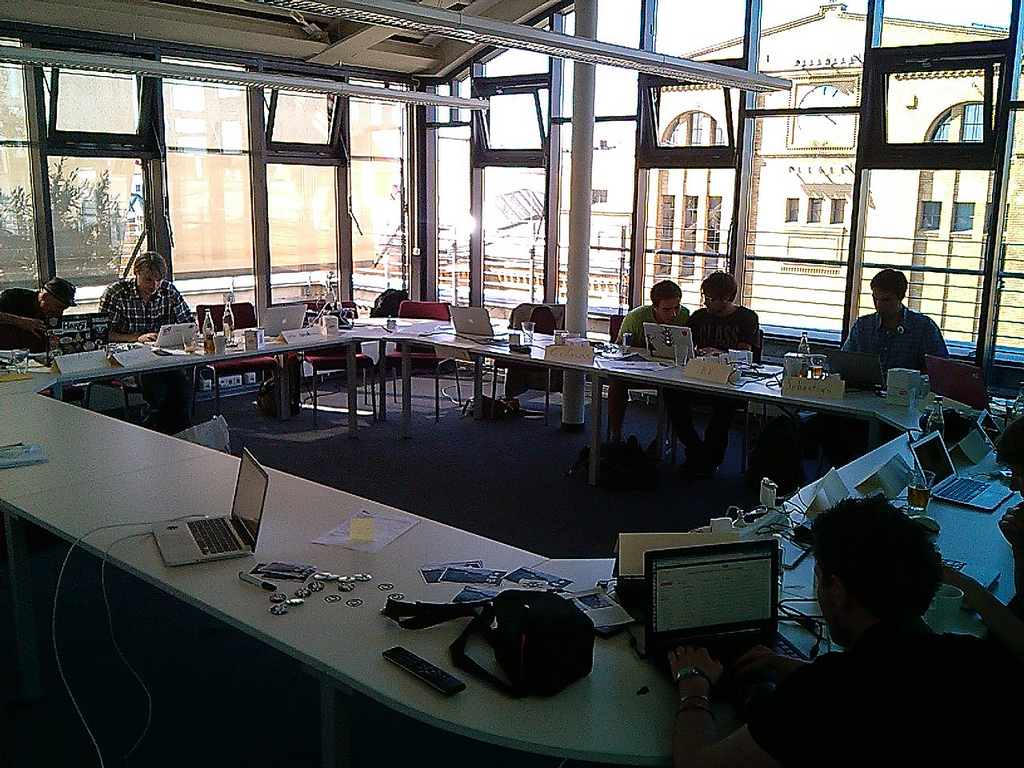
While it was 100% men — sadly not atypical for this sort of gathering — it was a diverse group of men: USA, Canada, Germany, Sweden, Ghana, France and Hungary were all represented.
While the hierarchy was pretty loose, PirateBox instigator David Darts and PirateBox coder Matthias Strubel, along with enthusiastic Frenchman Augustin Delaporte variously took the tentative helm.
We got a good grounding in the technical aspects of PirateBox from Matthias, a good grounding in the inspiration and history of PirateBox from David, and a good push toward organization and UI improvments from Augustin. We ate pizza, debated CMS platforms and GitHub repository layouts and talked about our favourite features-to-be.
There’s a lot in the “coming soon” column for PirateBox: easier installation, new website, an “extensions” framework, a shared core codebase with LibraryBox (which has blown through its Kickstarter plateau impressively), and better code organization in GitHub.
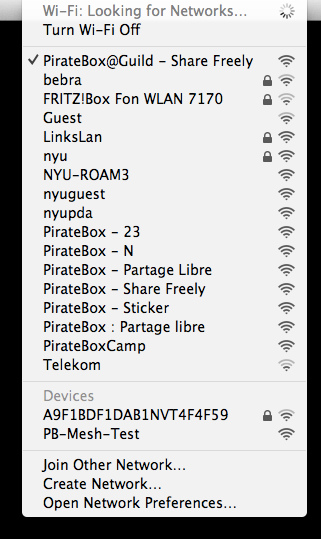
As I’d hoped, there was a lot of the spirit of Internet 1.0 in the room: smart minds concentrating on a mixture of the cool and the practical with no concern for anythingization. I came away energized and invigorated about the PirateBox idea, and even found some time to write up some documentation for a method for creating standalone “OpenStreetBoxes”, building on some work done here by Gael Musquet.
When things wrapped up on Saturday night, Olle and I bought some beer at the nearby grocery store and took the M10 tram to Hausburgpark where a barbeque organized by our friend (and consummate host and partygiver) Morgan was already underway, with a motely collection of Morgan’s friend from far and wide (including, as it turned out, 10% of the attendees from Zap Your PRAM 2008) eating grilled meat, fish and vegetables. And drinking beer, wine, and Pimm’s. Remember Pimm’s?
The barbecue continued on into the night, and I got a chance to meet many interesting people.

When it was all over we helped Morgan move things back to his nearby apartment and then Olle and I hopped in a cab (magically conjured up by Morgan’s iPhone) and were back at our Motel One base 15 minutes later.
Sunday morning PirateBox Camp was scheduled for a second day, and we planned with more care and eeked out coffee at Bonanza on the way there.

Leaving Luisa to wander, we joined our PirateBox compatriots for some more down-to-brass-tacks talk about the future organization of the project, shared a BitTorrent Sync secret (using a PirateBox, of course), and quietly hacked away in the spare moments.
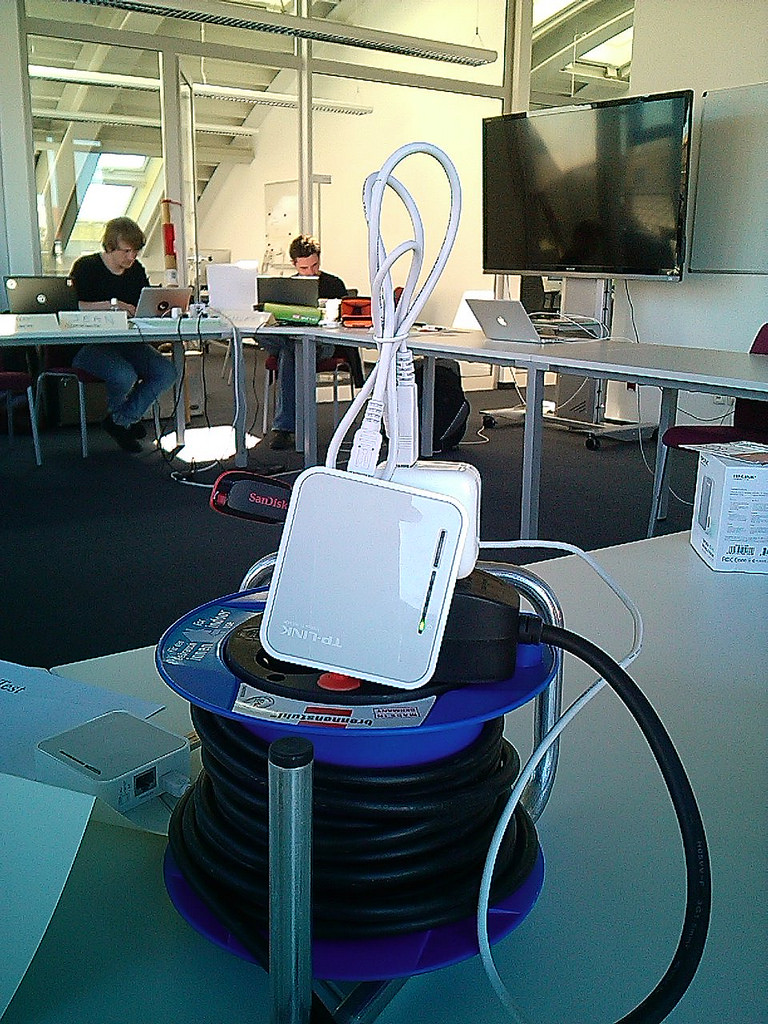
Olle and I said our farewells and ducked out at 1:00 p.m., just as lunch was arriving, so as to spend Olle and Luisa’s last afternoon in the city together.
We grabbed lunch at November (good food; dreadful service from overtaxed servers), coffee at The Barn Roastery (dreamy coffee and equally dreamy baristas), made a quick late-afternoon stop at the Makers Market and, finally, had a nice light supper at ChénChè.
We piled back to Moritzplatz so that Olle and Luisa good head to Tegel for their evening flight home to Malmö, leaving me to fend for myself until I head back to Canada on Wednesday morning.

Not content to simply stew in my hotel for the evening, I walked up Oranienstrasse to Eiszeit Kino for a late showing of UNPLUGGED: Leben Guaia Guaia, a rollicking German documentary (with English subtitles) about the band Guaia Guaia and their approach to life and music. Eiszeit Kino is a great little cinema with really friendly staff and two screens located off Zeughofstrasse down and alley and up the stairs. I was the only person in the theatre, which was a shame because it was a good movie and it deserves a bigger audience than just me (perhaps I am leading or following the pack?). See it if you can.
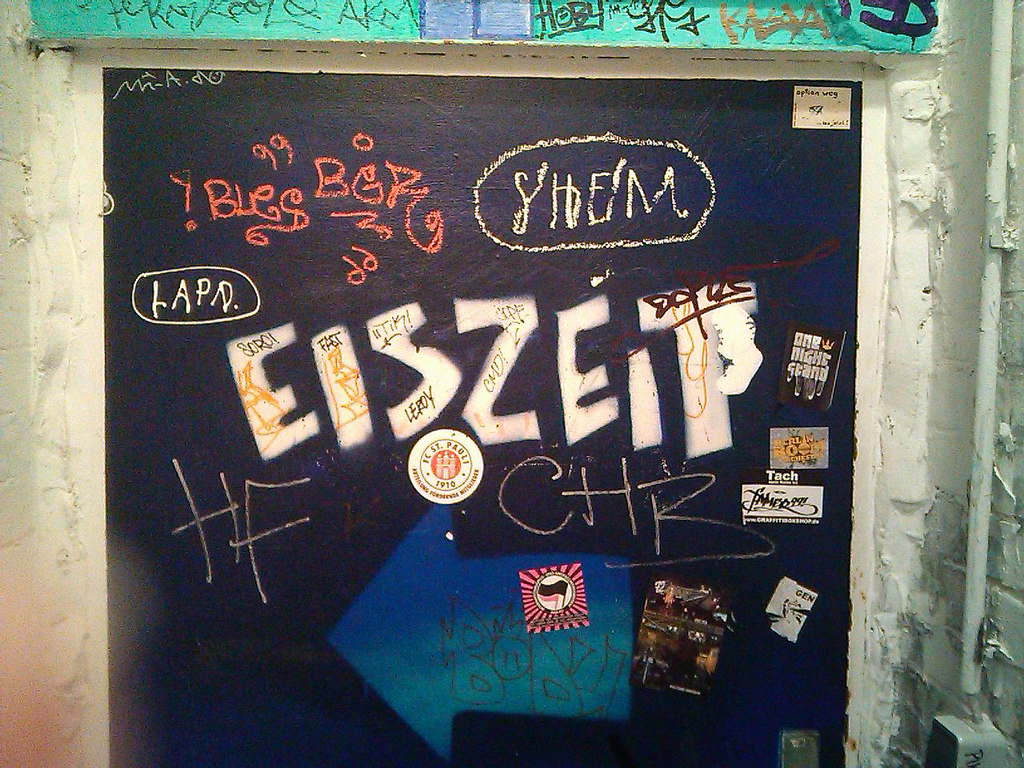
For my last two days in Berlin I’ve got a crowded dance card: I’m having a surgically-organized one-hour date with Martin Röll while he is on the way from Helsinki to meetings north of Berlin, coffee with Igor and a tour of the Third Wave office and, on Tuesday, drinks with my old Plazes compatriots Jeanny and Til.
It’s a whirlwind trip, but I’m so glad I came: Olle told me of some advice he received recently which was, in essence, “when the workshop is set up, don’t wait, start working.” I’m a strong believer in not waiting until eventually to travel and see friends and engage with interesting projects; my workshop — an income, my health, a great network of generous friends — is set up, and while it takes some effort to get over the inertia (and comfort) of everyday life up and down Richmond Street, it’s important to leave the home orbit once in a while.
Which is, in part, why I write all this down: to remind myself to do it again soon.
While nominally here in Berlin for PirateBox Camp, which starts tomorrow, arriving two days early allowed me to spend today with Olle and Luisa, here in the same last-minute serendipitous spirit from their home in Malmö.
With no specific plans in mind, we set out after breakfast to see what we could see, and ended up contructing what amounted to an almost-perfect agenda of meals and snacks and coffee connected by walking and talking.
While we have workshopped this play before, in different cities and under different circumstances, this was the big time: coffee at Companion Coffee, lunch at 3 Schwestern, more coffee at KANT (lovingly crafted by Alper), ice cream at Eismanufaktur, cake and drinks at Hudson’s, a well-deserved break, followed by drinks at Suzie Fu and a late, late supper on the canal at Chan.
We did, I admit, take a detour into the Museum der Dinge mid-afternoon, and into Modulor in the early morning. And there was the unfortunate Yelp-mismanaged journey to a no-longer-operating Indian restaurant. But otherwise it was a day of walking and talking and eating.
It don’t get much better than that.
If you’ve been keeping abreast of all the hijinks over at my Hacker in Residence blog you’ll know that I’ve become interested in the PirateBox project, an ingenious “make a wireless webserver on a $35 box” project. I love the project for many reasons, perhaps most for how much it evokes the spirit of Internet 1.0, back before SEO and “social media marketing” and analytics and monetization, the Internet driven by View | Source. The notion of creating a box that is not connected to the Internet, on purpose, is an oddly powerful idea.
As such, when PirateBox Camp was announced, I knew in my heart-of-hearts that I had to attend. Besides, it’s in Berlin. In the summer. How could I not go.
I must admit that the notion of a “camp” for PirateBox seems, on the surface, completely absurd. Of course that only increases the attraction: only absurd people will go to an absurd camp, and so I’m sure there will be all sorts of interesting discussion and hacking happening on Saturday and Sunday.
As an added bonus, Olle and Luisa are jetting down from Sweden for the weekend, and Morgan is already there, so it will be like old home week.
That all of this is the result of a single photo that Mita (Zap Your PRAM alumnus) pushed to Flickr in April, a photo that piqued my curiousity, ties the knot of the happenstancery of it all.
I’m off to Berlin tomorrow night, and I’m there until next Wednesday morning.
Let the absurdity begin!

 I am
I am